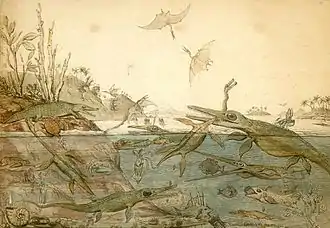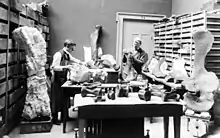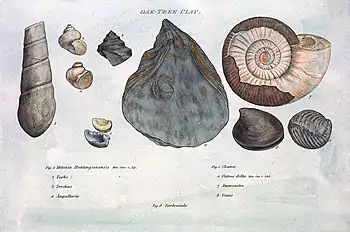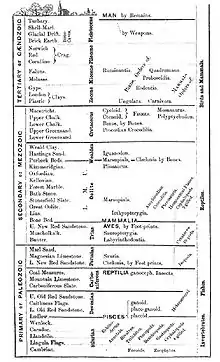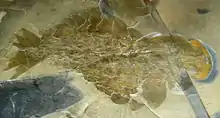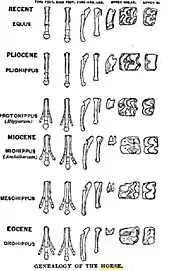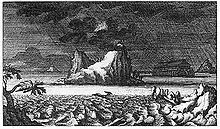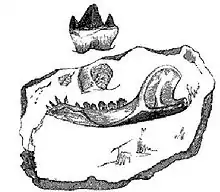Portal:Paleontology
|
The Palaeontology Portal
Introduction A paleontologist at work at John Day Fossil Beds National Monument Paleontology (/ˌpeɪliɒnˈtɒlədʒi, ˌpæli-, -ən-/), also spelled palaeontology or palæontology, is the scientific study of life that existed prior to, and sometimes including, the start of the Holocene epoch (roughly 11,700 years before present). It includes the study of fossils to classify organisms and study their interactions with each other and their environments (their paleoecology). Paleontological observations have been documented as far back as the 5th century BC. The science became established in the 18th century as a result of Georges Cuvier's work on comparative anatomy, and developed rapidly in the 19th century. The term has been used since 1822 formed from Greek παλαιός ('palaios', "old, ancient"), ὄν ('on', (gen. 'ontos'), "being, creature"), and λόγος ('logos', "speech, thought, study"). Paleontology lies on the border between biology and geology, but it differs from archaeology in that it excludes the study of anatomically modern humans. It now uses techniques drawn from a wide range of sciences, including biochemistry, mathematics, and engineering. Use of all these techniques has enabled paleontologists to discover much of the evolutionary history of life, almost all the way back to when Earth became capable of supporting life, nearly 4 billion years ago. As knowledge has increased, paleontology has developed specialised sub-divisions, some of which focus on different types of fossil organisms while others study ecology and environmental history, such as ancient climates. (Full article...) Selected article on the prehistoric world and its legacies
Aetosaur fossil remains are known from Europe, North and South America, parts of Africa and India. Since their armoured plates are often preserved and are abundant in certain localities, aetosaurs serve as important Late Triassic tetrapod index fossils. Many aetosaurs had wide geographic ranges, but their stratigraphic ranges were relatively short. Therefore, the presence of particular aetosaurs can accurately date a site that they are found in. Aetosaur remains have been found since the early 19th century, although the very first remains that were described were mistaken for fish scales. Aetosaurs were later recognized as crocodile relatives, with early paleontologists considering them to be semiaquatic scavengers. They are now considered to have been entirely terrestrial animals. Some forms have characteristics that may have been adaptations to digging for food. There is also evidence that some if not all aetosaurs made nests. (see more...) Did you know?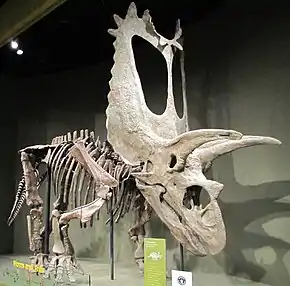 A skeletal mount of Titanoceratops
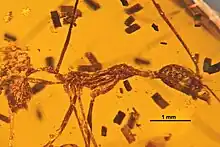 An Aphaenogaster amphioceanica preserved in amber
General images -The following are images from various paleontology-related articles on Wikipedia.
Selected article on paleontology in human science, culture and economics.png.webp) A Marella fossil. Paleontology lies on the border between biology and geology. It now uses techniques drawn from a wide range of sciences, including biochemistry, mathematics and engineering. Use of all these techniques has enabled paleontologists to discover much of the evolutionary history of life, almost all the way back to when Earth became capable of supporting life, about 3,800 million years ago. As knowledge has increased, paleontology has developed specialized sub-divisions, some of which focus on different types of fossil organisms while others study ecology and environmental history, such as ancient climates. Body fossils and trace fossils are the principal types of evidence about ancient life, and geochemical evidence has helped to decipher the evolution of life before there were organisms large enough to leave fossils. (see more...) On this day...October 25:
Selected image
CategoriesCategory puzzle Select [►] to view subcategories
Paleontology Paleontology by country Subfields of paleontology Paleontology awards Paleontology in the Caribbean Paleontological concepts and hypotheses Economic paleontology Evolution of the biosphere Fossil record History of paleontology Paleontological institutions and organizations Prehistoric life Paleontology lists Paleontology mass media Paleontological sites Paleontologists Paleontology by year Paleontology stubs TopicsGeneral - Paleontology - Fossil - Evolution - Extinction Quality ContentFeatured paleontology articles
- Achelousaurus
- Acrocanthosaurus
- Albertosaurus
- Allosaurus
- Amargasaurus
- Ankylosaurus
- Apatosaurus
- Archaeopteryx
- Baryonyx
- Carnotaurus
- Catopsbaatar
- Ceratosaurus
- Chicxulub Crater
- Compsognathus
- Cretaceous–Tertiary extinction event
- Daspletosaurus
- Deinocheirus
- Deinonychus
- Deinosuchus
- Dilophosaurus
- Dinosaur
- Diplodocus
- Dromaeosauroides
- Edmontosaurus
- Elasmosaurus
- Giganotosaurus
- Gorgosaurus
- Herrerasaurus
- Iguanodon
- Istiodactylus
- Lambeosaurus
- List of dinosaur genera
- Majungasaurus
- Massospondylus
- Megalodon
- Nemegtomaia
- Nigersaurus
- Opisthocoelicaudia
- Paranthodon
- Parasaurolophus
- Plateosaurus
- Psittacosaurus
- Seorsumuscardinus
- Spinosaurus
- Stegosaurus
- Stegoceras
- Styracosaurus
- Tarbosaurus
- Thescelosaurus
- Triceratops
- Tyrannosaurus
- Velociraptor
Things you can do
Current Paleontology FACs - None yet... WikiProjects
Related portalsAssociated WikimediaThe following Wikimedia Foundation sister projects provide more on this subject:
Discover Wikipedia using portals
|

